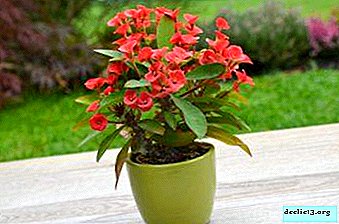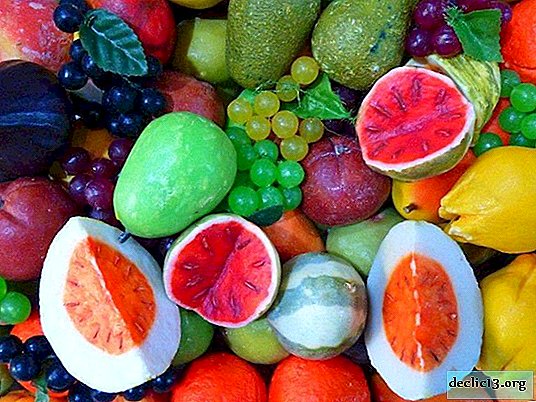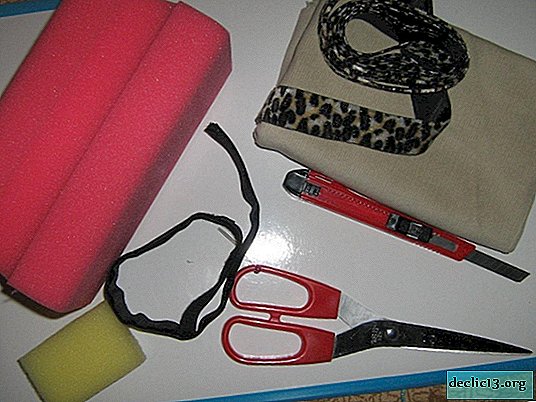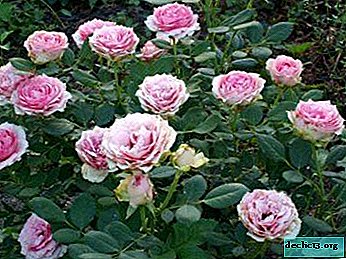A variety of lemon pests. Methods of control and prevention
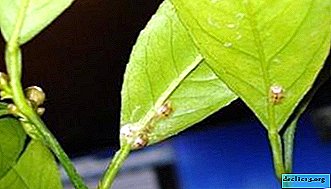
Lemon is a citrus plant unprotected from parasite attacks. The most common pests are sucking insects.
This group includes scale insects, aphids, thrips, spider mites, nematodes, and false shields. To get rid of parasites, it is necessary to wash the plant and prepare toxic agents.
For a more effective pest control, you will need to find out and eliminate the cause of their occurrence, familiarize yourself with preventive measures.
Types: description, photo, causes of appearance and treatment at room conditions
There are several main causes of pests on home lemon:
- parasites can enter the room from the street through an open window;
- insect eggs often end up in purchased soil;
- pests are attracted by dry warm air in the apartment.
Shield

In appearance, scabies resemble turtles, the size of which does not exceed 5 mm. Lemon is attacked not only by adults, but also by larvae. The latter are characterized by a high speed of movement, therefore, they are able to move from one plant to another. Upon reaching the target, the larvae attach to the veins on the leaves and fruits of the lemon.
At the initial stage of growth, the scales are distinguished by white color and translucency. In the process of development, they produce a fluid from special glands on the back, which forms a light gray shield on their body. The exoskeleton protects the insect from being sprayed with pesticides. The parasite takes a round shape.
Unlike larvae, adults do not move. During the year they breed offspring 2-3 times. Due to parasites, the leaves quickly turn yellow and fade, covered with a sticky coating. Lemon yield falls.
It is easier to get rid of a small colony when the insects are least mobile. During this period, it is necessary to collect the scab manually, after which you need to wipe the affected area with cotton wool with alcohol or a solution of laundry soap. To combat a large number of insects, the preparation of folk remedies will be effective:
- Capsicum broth. 10 g of dried fruit should be poured 1 liter of water. The mixture must be boiled for half an hour and left for 48 hours. Before using the product 1 tbsp. a thick mixture will need to be diluted in 1 liter of water, adding 1 tablespoon to the liquid grated laundry soap. 2 hours after application, the plant can be washed with water. The cleaning procedure should be carried out every 2 weeks until the parasites completely disappear.
- Water-oily emulsion. In 250 ml of warm water you will need to mix thoroughly 1 tsp. machine oil, 40 g of grated laundry soap and 2 tbsp. l powder for washing clothes. The resulting solution should soak cotton wool, wipe it with all the surfaces of leaves and branches.
It is necessary to avoid hit of means in soil. To avoid weakening the plant, you need to cover the soil with cling film before starting chemical treatment. After 4 hours after the procedure, wash the plant in the shower.
- Garlic mixture. To prepare the product you will need to grate garlic and laundry soap. The resulting mass must be filled with water in a ratio of 1: 1: 3. The homogeneous mixture should be distributed over the entire surface of the lemon with a toothbrush. Rinse with water after 60 minutes.
We offer you to watch a video on how to get rid of scabies with lemon damage:
Aphid

Aphid is a small sucking insect with a round body, not exceeding 1-5 mm. The insect practically does not move, has a different color - distinguish between yellow, white, green and black parasites. They multiply rapidly. Arthropod drinks lemon juice, settling in the form of colonies on the underside of young leaves, in buds and flowers. Aphid is a carrier of viral diseases for plants.
The leaves affected by parasites are deformed or curled.. Plant growth slows down or stops. Gradually lose color and become thinner. Aphids emit a sweet liquid, so the surface of the leaf becomes sticky.
To remove aphids, carefully wash the leaves, branches and trunk of the lemon with a soap solution. To prepare it, you need to dissolve 30 g of laundry soap in 1 liter of water. During the procedure, the soil should be covered with a film. As an additional tool, poisonous substances can be added to the solution:
- Tobacco leaf infusion. 50 g of dry collection should be infused in 1 liter of water for 24 hours, after which the liquid should be boiled for 2 hours. The resulting product should be diluted with 1 liter of water.
- Garlic husk infusion. 40 g of husk need to pour 3 liters of water and insist for a day.
- Onion husk product. 30 g of onion husks need to pour 1 liter of water. The fluid should be infused for 5 days. Before adding laundry soap, the solution must be filtered.
Thrips

Thrips have a whitish elongated shape with a pointed abdomen. The size of the insect varies from 0.5 to 3 mm in length. The paws of the pests are equipped with bubble-shaped suction cups, thanks to which the pests are characterized by a high speed of movement. Adult individuals differ from larvae only in the presence of shiny narrow wings.
Insects parasitize on lemon leaves by drinking vegetable juice. It is possible to identify the lacustrine by the silvery smudges that remain when the thrips move along the leaves. Light spots appear on the surface of the plant. Leaves discolor and quickly fade, flowers are deformed. Tree growth is slowing.
To combat them in a room environment, you can use the following tools:
- Mustard infusion. 70 g of ground mustard powder must be diluted in 1 liter of boiling water and mix thoroughly until a homogeneous mass is obtained. The resulting mixture must be infused for 3 days in a sealed container. Before processing the lemon tree should be diluted with water in a ratio of 1: 3.
- Dandelion-based infusion. 30 g of plant roots or 50 g of leaves must be filled with water at a temperature of + 50 ° C. The mixture should be left in a warm place for 4 hours, after which the solution should be filtered. Liquid needs to be sprayed on all surfaces of branches and leaves.
- Broth from tomato shoots. 500 g of tops need to pour 1 liter of water and boil for 30 minutes over low heat. The resulting suspension should be diluted with water in a ratio of 1: 3, and then used for processing lemon.
- Potato leaf infusion. 10 g of young or 75 g of dried shoots must be filled with 1 liter of hot water and insisted for 3 hours. After this time, the mixture should be filtered.
Spider mites

Adult pests reach 1 mm in length. On the head of the insect are 2 red spots that perform a visual function. The body of the insect is oval in shape, covered with fine bristles, red or pink. Parasites multiply rapidly on the lower surface of leaves in a room with dry air and high temperature. With increased humidity, insects hibernate, digging holes in the ground.
The first sign of the presence of a parasite is the appearance of small yellow spots on the leaves, which acquire a brownish tint over time. Lemon tree is covered with cobwebs. Young shoots dry up, productivity worsens.To combat large colonies, it is recommended to use an ultraviolet lamp. Once a week, leave the plant under radiation for 2 minutes. Folk remedies are effective against a few individuals:
- Yarrow infusion. 10 tbsp dry collection, pour 1 liter of boiling water and leave for a day under a closed lid. Before processing, strain the solution.
- Sulfur-lime broth. In 300 ml of water you need to dilute 20 g of lime and 40 g of powdered sulfur. The resulting mixture should be boiled over low heat for an hour. Before processing, it is necessary to dilute the concentrate with water, the volume of which is 20 times the mass of the broth.
- Garlic clove infusion. 100 g of the product must be passed through a garlic squeezer or grated. The crushed mass must be filled with 1 liter of water, insisted for 5 days. Before spraying the lemon, dilute 50 ml of the solution in 1 liter of water. 2 hours after treatment, rinse the lemon with water. The procedure must be repeated every 5 days until the parasites completely disappear.
As a preventive measure against spider mites, optimal indoor air humidity should be maintained and the tree leaves should be periodically wiped with a damp cloth.
We suggest watching a video on how to deal with a spider mite on a lemon:
False shields

In appearance, they coincide with the description of the thyroid: a convex, kidney-shaped body with a characteristic shield on the back. Differ in shell color - brown shade of exoskeleton in false shields.
The scutellum is not a wax shell formed during growth, but the drying skin of a dead female. Insects drink vegetable juice, settling in different parts of the aerial parts of the lemon.
With severe parasite damage, the leaves along the veins are covered with plaque from a large number of insects. There is a delay in the growth and development of the lemon tree, the leaves turn yellow and fall off. False shields secrete sticky fluid - pad, on which a soot fungus in the form of black dots subsequently forms.
Rubbing leaves with a solution of laundry soap and anabazine once a week helps get rid of pests. Instead of liquid for spraying, you can use onion juice.Worms

Worms are similar in appearance to larger aphids. Pests are highly fertile. Colonies of parasites are evenly distributed over the entire surface of the lemon, feed on citrus juice and secrete a sweet secret. Most often, the plant is attacked by mealybugs or felt, affecting the root system.
After parasites, a loose white coating remains on the leaves, which is the first sign of the appearance of pests. The development of black dots indicates the presence of colonies living on lemon for a long time. These are sooty mushrooms that grow on the plant due to the sweet secretions of insects.
To get rid of parasites, you can wipe the leaves with water or soap solutions. Worms are sensitive to moisture, so they can’t tolerate the cleaning of the plant. For prevention, you can hold a cotton swab with alcohol over the entire surface of the lemon.Nematodes

Compared with other pests of citrus nematodes, they multiply in the soil and affect mainly the root system of the plant, but they can also parasitize on the aerial parts of the lemon. Nematodes are microscopic roundworms whose size does not exceed 2 mm.
The leaves affected by the worms are covered with yellow spots and quickly discolored. Gradually, the root of the lemon dies from necrosis. Signs of damage appear on the aerial part of the plant.: leaves twist, citrus ceases to bear fruit and grow.
To combat nematodes, disinfect pots with soil, keeping in boiling water for 60 minutes. The soil will need to be replaced. The place where the pot stood should be disinfected with alcohol.
Pesticides or folk remedies will not help against nematodes.In rare cases, nematodes can be confused with earthworms. The latter fall into the pot from the street and appear on the surface if the plant is watered abundantly. Despite their harmlessness to lemon, they can be carriers of diseases dangerous to humans.
To remove the worms, you need to water the plant with water at a temperature of + 40 ° C. After the raincoats get to the surface, they should be collected and discarded. The procedure needs to be repeated several times.
Prevention
Prevention measures help reduce the risk of lemon damage by pests:
- A thorough inspection of purchased plants. For 3-4 weeks, you should keep the purchased flower in quarantine - put separately from other indoor flowers. Throughout the period, the plant should be carefully examined for the presence of parasites. The leaves of the flower should be washed with water or an alcohol solution.
- Bouquets of flowers should be placed away from indoor plants.. Parasites can enter the room with other plants or in flowers grown outdoors. Therefore, you should put the bouquets in a place isolated from other plants. This preventative measure will help prevent the proliferation of insects.
- Periodic shower rinse. 1 time a month should wash the leaves and branches of a lemon tree with running water. Before the procedure, cover the soil with a film.
Lemon pests are quick to breed and often colonize in the aerial parts of the plant. Insects or traces of their stay on a room flower can be seen with the naked eye. Therefore, when plaque or spots appear on the leaves, the parasite should be identified as soon as possible and measures should be taken to eliminate it. If there are no traces of insects on the surface, it is necessary to loosen a small area of soil to identify the method.

